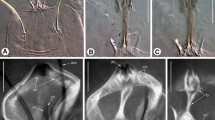Summary
The burrowing behaviour of the carabid beetleScarites buparius is described. Like most other Scaritini, although this species digs deep holes in sandy areas. The burrowing behaviour ofScarites is basically different from that of other carabid beetles so far observed. When burrowing, unlike many other burrowing animals, no alternative motions are carried out by the deeply flattened foretibias. Instead, the tibias are held beside the long mandibles and the broadly flattened underparts of the head which is bent downwards. In that manner a very large shovel-like area is built. By moving backwards the beetle carries all the sand out of his hole, which is behind the ‘shovel’.
Comparative measurements of foretibias, gula and mandibles of theScarites buparius andCarabus coriaceus, a carabid of similar size, showed that in theScarites these organs are 4–5 times as large as in theCarabus. Thus, the burrowing equipment ofScarites is very efficient. Because of these measurements and the method of burrowing, there is great weight and heavy friction on the forelegs of scaritini during burrowing.
The morphological conditions are described for overcoming these obstacles through the shape of the body and elytra and in the structure of the skeleton and musculature of the prothorax. Friction is reduced by the parallel and somewhat cylindrical body shape, by the highly polished surface, and by the shortening of the procoxae which fit closely in the prothorax.
The complicated ventral articulation of the procoxae and the enormously strengthened remotor muscles of the procoxa, which are modified by their position, stabilize the forelegs in the course of heavy straining during burrowing and prevent their turning forward. As the origin of the coxal remotors is situated far in front of their insertion at the coxa, these muscles are exceptionally efficient.
The possibility of different evolutionary pathways is discussed, since there are enormously different sizes within Scaritini resulting in different mechanical relations between beetle and substrate.
Zusammenfassung
Grabverhalten und Ablauf des Grabvorganges des LaufkäfersScarites buparius werden beschrieben. Diese Art, wie viele andere Scaritini, legt in sandigen Gebieten lange Gänge an.
Das Grabverhalten vonScarites unterscheidet sich grundlegend vom Grabverhalten anderer Carabidae, soweit dies bekannt ist. Beim Graben führen die verbreiterten Vordertibien keine alternativen Bewegungen aus, wie es bei vielen anderen grabenden Tieren üblich ist. Sie werden vielmehr während des Grabens seitlich der breiten und abgeflachten Unterseite des nach ventral angebogenen Kopfes und der langen Mandibeln gehalten. Dadurch entsteht eine einheitliche, sehr großflächige „Schaufel“, mit deren Hilfe der sich hinter ihr befindliche Sand unter Rückwärtslaufen des Käfers aus der Röhre geschafft wird.
Messungen an Vordertibia, Gula und Mandibeln vonS. buparius undCarabus coriaceus, einem Carabiden vergleichbarer Größe, ergaben eine 4-5fach größere Oberfläche dieser Körperteile beiScarites. Diese Graborgane sind daher vergleichsweise sehr leistungsfähig.
Aus diesen Messungen und aus der Art des Grabens ergibt sich, daß bei den Scaritini außerordentliche Belastungen vor allem an den Vorderbeinen sowie große Reibungswiderstände auftreten müssen.
Die anatomischen Voraussetzungen zur Überwindung dieser Erschwernisse in Körperform und Flügeldeckenstruktur sowie im Bau von Skelett und Muskulatur des Prothorax werden dargestellt.
Der Reibungswiderstand wird durch die parallele, im Querschnitt rundliche Körperform, durch die sehr glatte Oberfläche, sowie die Verkürzungen und Einpassungen der Procoxae in den Prothorax herabgesetzt.
Similar content being viewed by others
Literatur
Baehr, M.: Vergleichende Untersuchungen am Skelett und an der Coxalmuskulatur des Prothorax der Coleoptera. Ein Beitrag zur Klärung der phylogenetischen Beziehungen der Adephaga (Coleoptera, Insecta). Diss. Tübingen 1979
Monographie der Subtribus Scaritina (Col. Carab.). Deutsche Ent. Z. 1937–1939
Britton, E.B.: Coleoptera. In: The Insects of Australia, 495–621, Melbourne: University Press 1970
Burmeister, F.: Biologie, Ökologie und Verbreitung der europäischen Käfer auf systematischer Grundlage. I. Adephaga I. Familienreihe: Caraboidea. Krefeld: Goecke 1939
Crowson, R.A.: The natural classification of the families of Coleoptera. 2. ed. Hampton: Classey 1967
Hlavac, T.F.: A review of the species ofScarites (Antilliscaris), (Coleoptera: Carabidae) with notes on their morphology and evolution. Psyche, Cambridge76, 1–17 (1969)
Hlavac, T.F.: Differentation of the carabid antenna cleaner. Psyche, Cambridge78, 51–66 (1971)
Hlavac, T.F.: The Prothorax of Coleoptera (except Bostrichiformia — Cucujiformia). Bull. Mus. comp. Zool.147 (4), 137–183 (1975)
Jeannel, R.: Coléoptères carabiques. In: Faune de France39, Paris 1941
Jeannel, R.: Coléoptères carabiques de la Région Malgache I. Faune Emp. Fr. 6, Paris 1946
Larsén, O.: On the morphology and function of the locomotor organs of the Gyrinidae and other Coleoptera. Opusc. Ent. Suppl.30, 1–241 (1966)
Lindroth, C.H.: The ground beetles (Carabidae, excl. Cicindelinae) of Canada and Alaska. Opusc. Ent. Suppl. 1961–1969
Regenfuß, H.: Die Antennen-putzeinrichtung der Adephagen (Coleoptera), parallele evolutive Vervollkommnung einer komplexen Struktur. Z. zool. Syst. Evolutionsforsch.13 (4), 278–299 (1975)
Schmalfuß, H.: Morphologie und Funktion der tergalen Langsrippen bei Landisopoden (Oniscoidea, Isopoda, Crustacea). Zoomorph.86, 155–167 (1977)
Tietze, F.: Untersuchungen über die Beziehungen zwischen Flügelreduktion und Ausbildung des Metathorax bei Carabiden unter besonderer Berücksichtigung der Flugmuskulatur. Beitr. Ent.13, 88–167 (1963)
Author information
Authors and Affiliations
Rights and permissions
About this article
Cite this article
Baehr, M. Grabverhalten und Prothorax-Morphologie vonScarites buparius Forster als Beispiel für die Anpassung derScaritini an die grabende Lebensweise (Coleoptera, Carabidae). Zoomorphologie 93, 245–263 (1979). https://doi.org/10.1007/BF00994002
Received:
Issue Date:
DOI: https://doi.org/10.1007/BF00994002




